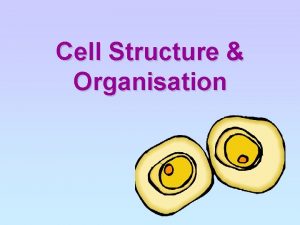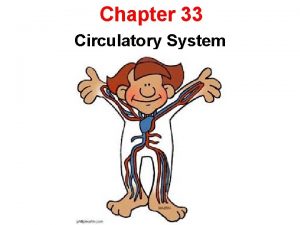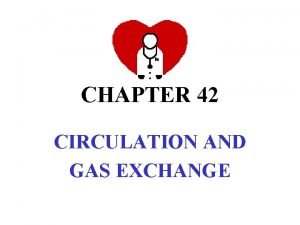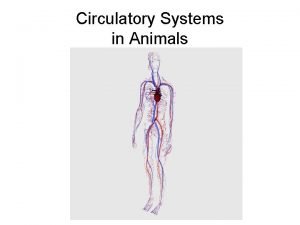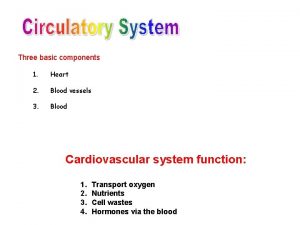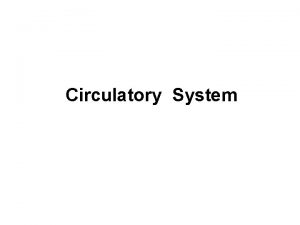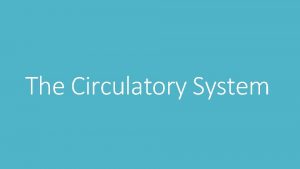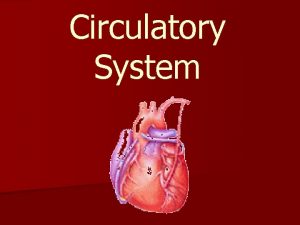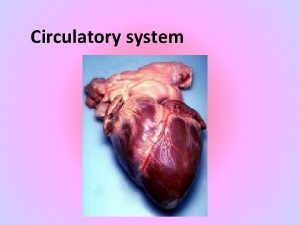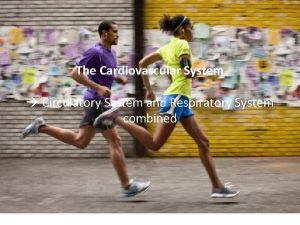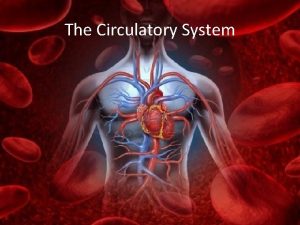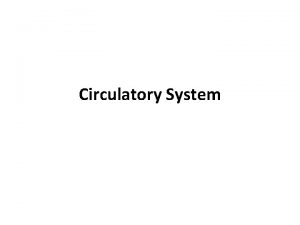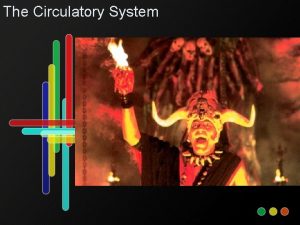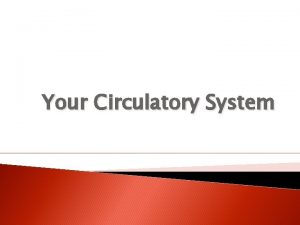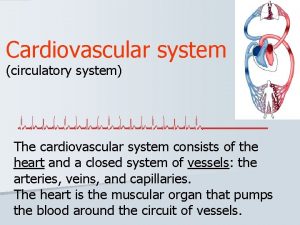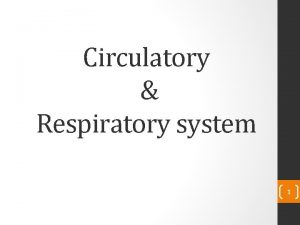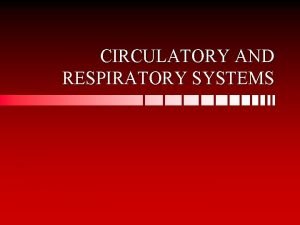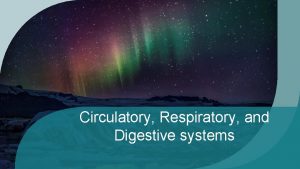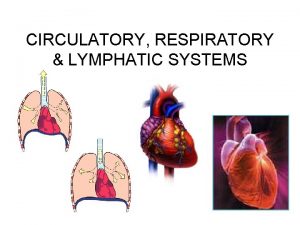Cardiovascular System Power Point Presentation Circulatory and Respiratory
























- Slides: 24

Cardiovascular System Power. Point Presentation Circulatory and Respiratory Unit PSE 4 UI

1. Purposes of the Cardiovascular System a. To provide a constant supply of oxygen and glucose to the body b. To maintain homeostasis by transferring heat energy c. To remove wastes and prevent infection by means of clotting

2. Components: a. Heart: The pump which sends the blood to the lungs and the body b. Vessels: Arteries, capillaries and veins transport blood to various parts of the body c. Blood: Composed of red and white blood cells, platelets and plasma

3. Systemic Circuit Left side of heart Blood is sent to inferior/ superior aspects of body under high pressure Returns deoxygenated blood to right heart via veins Pulmonary Circuit Right side of heart Deoxygenated blood is sent to the lungs under high pressure Oxygenated blood returns to left atrium via pulmonary vein

4. Cardiac Cycle Systole The contraction of the heart (pumping action) Electrical and mechanical changes Stimulus from sino-atrial node E. g. blood volume changes Diastole The relaxation or filling of the heart muscle Takes twice as long as systole Pump needs to be “primed” Systole = 0. 3 s Lowest blood pressure in body

5. Arterial Blood Pressure Expressed as systolic diastolic Normal – 120 mm Hg High – 80 mm Hg Systolic pressure (top number) -this is the pump phase of the heart or the highest pressure of within the blood vessels Diastolic pressure -this is the filling stage of the heart or the lowest pressure

6. Blood Pressure Pulse Pressure (PP) Difference PP = Systolic - Diastolic Mean Arterial Pressure ( MAP ) Average MAP = Diastolic + 1/3(Systolic – Diastolic)

7. Sedintery Lifestyle/Stress Body Position Age Male/Female Chemical Influence Stimulants (ie. Caffeine, etc. ) Physical Limitations (ie. Arteriosclerosis/Atherosclerosis)

8. Causes of High Blood Pressure Age Race Heredity Diet Stress Inactivity

9. Electrical Activity of the Heart Contraction of heart depends on electrical stimulation of myocardium The sino-atrial node (SA node) or the pacemaker will heart to contract 70 -80 times per minute The atrio ventricular node (AV node) will transfer that initial electrical impulse to the muscular walls of the ventricles

10. Atrial Stimulation Pathway Internodal Pathways Atrioventricular Node Bundle of His Right and Left Bundle Branches Purkinje fibres Electrocardiogram (EKG) Records electrical activity of the heart P wave Atrial depolarization QRS complex Ventricular depolarization T wave Ventricular repolarization

11. Cardiac Output (Q) Q = Cardiac Output or Q = f. H x Vs Where: Q = Heart Rate x Stroke Volume f. H = Heart Rate Vs = Stroke Volume

12. Cardiac Output: the amount of blood that is pumped out of the left ventricle in one minute (L/min) Range of normal at rest is 5 -6 L/min During aerobic activity 20 L/min Max. Q is greater than 30 L/min

13. Heart Rate: the number of times that the heart contracts in a minute Range of normal at rest is 60 – 80 beats/min Increases in Max. 220 – Age (Submaximal heart rate) Medications or upper body exercise can incrementally increase heart rate

14. Stroke Volume the amount of blood that is ejected from the left atrium in a single beat Range of normal at rest is affected by exercise During exercise, stroke volume increases depending on the intensity of the activity Max. SV is 180 ml Increased SV during rhythmic aerobic exercise is due to increased aerobic demand

15. Frank Starling Law of the Heart The heart will pump and stretch at a rate that will allow it to increase the strength of the contraction

16. Components of Blood Plasma (55% of blood) 90 % water 7% plasma proteins (3% other (acids and salts) Cells Red blood cells (RBC) or erythrocytes White Blood Cells WBC) or leukocytes Platelets Fibrinogen protein used for clotting purposes Hematocrit Part of hemoglobin complex which is used to transport oxygen

17. Oxygen Delivery During Exercise Oxygen demand by muscles during exercise is determined by carbon dioxide concentration in blood Increased oxygen delivery accomplished by: Increased cardiac output Improved delivery of oxygen (VO 2 max)

18. Circulatory Responses to Exercise, Heart Rate and Blood Pressure Depend on: Intensity of activity Duration of activity Ability of body to remove fatigue products such as lactic acid

19. Transition from rest> exercise and exercise> recovery Rapid increase in initial respiratory rate Plateau in aerobic capacity due to training effect. Most athletes use cross training to “fool” muscles Recovery depends on: Duration and Intensity Ability to train and flush lactic acid

20. Incremental Exercise Heart rate and cardiac output Raises at an exponential rate Stabilizes at a target heart rate Systolic blood pressure The heart does not need to pump as hard under submaximal conditions Double product Increases linearly with intensity and duration Indicates the training level of the athlete Double product = the athlete can train longer while applying higher levels of intensity

21. Arm vs Leg Workout at the same oxygen uptake arm work results in higher: Heart rate increases due to the effect of gravity Blood pressure will actually lower over time due to the training effect

22. Prolonged Exercise Cardiac output is maintained Through regular physical activity (minimum 3 times a week/20 -30 minute intervals) Increasing levels of intensity to maximize training effect Cardiovascular drift This is caused due to dehydration and increased blood flow to the skin.

 Respiratory system circulatory system digestive system
Respiratory system circulatory system digestive system Circulatory system and respiratory system work together
Circulatory system and respiratory system work together Blood vesel
Blood vesel Tiny air sacs at the end of the bronchioles
Tiny air sacs at the end of the bronchioles Structure of cell
Structure of cell Chapter 33 section 1 the circulatory system
Chapter 33 section 1 the circulatory system Respiratory zone
Respiratory zone Anatomy and physiology unit 7 cardiovascular system
Anatomy and physiology unit 7 cardiovascular system Chapter 8 cardiovascular system
Chapter 8 cardiovascular system Hindi presentation topics
Hindi presentation topics Power point presentation design west vancouver
Power point presentation design west vancouver Difference between open and closed circulatory system
Difference between open and closed circulatory system Amphibian and reptile circulatory system
Amphibian and reptile circulatory system Grade 9 circulatory system parts and functions
Grade 9 circulatory system parts and functions What makes up the circulatory system
What makes up the circulatory system Pithed rat model
Pithed rat model Its tubular dude
Its tubular dude Crash course heart
Crash course heart Chapter 5 the cardiovascular system labeling exercises
Chapter 5 the cardiovascular system labeling exercises Figure 11-7 veins labeled
Figure 11-7 veins labeled Figure 11-8 arteries
Figure 11-8 arteries Lesson 11 cardiovascular system
Lesson 11 cardiovascular system Lesson 11 cardiovascular system
Lesson 11 cardiovascular system Tissues in the circulatory system
Tissues in the circulatory system Anatomy blood vessels
Anatomy blood vessels




